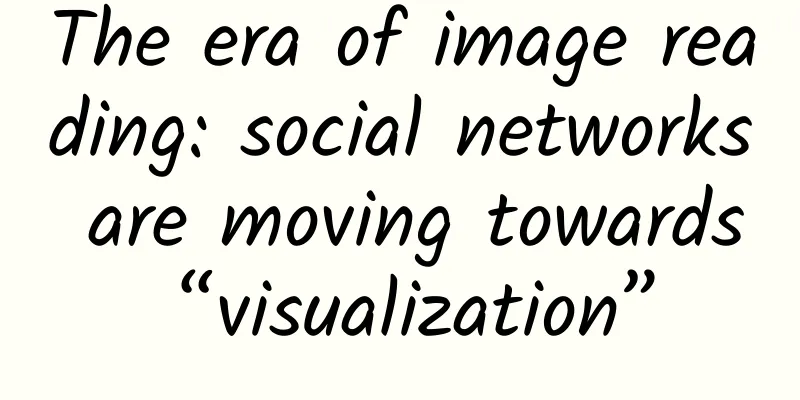The era of image reading: social networks are moving towards “visualization”

|
The rise of image social networking sites such as Pinterest is the best proof of the visual nature of social networks The following is the full text of the article: The new language of social media is no longer words, but images. No matter which social network you go to, the most engaging content is accompanied by images. Why are images suddenly surpassing words on social networks? And what impact will this trend have on your electronic devices? Why images dominate The rise of blogs as a public news platform all stems from the power of words. One of the earliest and best blogs in existence, Dave Winter's Scripting News, had almost no visual elements. About 12 years ago, a surge of excellent blogs on a variety of topics began to emerge. Soon, there was an endless supply of excellent content, and it was hard to keep up. When Twitter emerged about five years ago, many people wondered why it became so popular so quickly, but in hindsight, the answer seems obvious: Twitter made it easy to follow a lot of people without any burden. Whether you look at it or not, the news is there. If you can follow 20 great blogs, you can follow 50 RSS feeds or 1,000 Twitter accounts with the same amount of time and effort. If you understand that every revolutionary advance in social media—from blogs to RSS to Twitter—has increased the amount of content people can process, then you can understand why images are bound to be the next revolution. It’s a response to social network fatigue: We’ve evolved from reading a few blog posts to scrolling through a lot of Twitter feeds, and are now just beginning to be “moved” by content paired with images. There are two major changes at present. First, the habits of ordinary readers are shifting from high-quality and large-volume detailed content to simple and easy-to-read information. Second, the number of participants is increasing day by day. Granted, the number of people who can actually express insightful opinions has not increased, but nowadays, everyone is participating in social networks. However, many people are just casual spectators. In addition, under the human tendency, we are always curious about other worlds, other places, and other people's lives. We need to see and feel the lives of others. Text can indeed play a certain role, but for ordinary people, taking pictures with mobile phones seems to be easier and faster. Image globalization Social media is becoming a global world. For example, if you look at the global distribution of Google+ users, Americans account for less than 29%. The combined number of users in India and Brazil is roughly the same as that in the United States. Among the top 30 countries and regions, only four speak English. That’s why a lengthy text description is unlikely to be widely circulated, even in English, whereas a photo of a beautiful sunset is likely to attract the attention of everyone, regardless of language or region. A look at the "What's Hot" list on Google+ shows lots of sunset photos and other images that resonate around the world. But there's nothing like pure text. The vast majority of articles on Google+ do not contain full-size images, but in "What's Hot", more than 90% of the content is accompanied by full-size images. Not every image will go viral on Google+, though. A successful social image is one that is clearly perceived by others. Jokes, humor, pain, awe, disgust—there is no ambiguity because everything is so direct. Explaining Silicon Valley's weirdness The rise of the visual web explains a lot of Silicon Valley oddities. Why did Pinterest, for example, surpass Yahoo to become the fourth-largest traffic driver on the Web? Why did Facebook spend so much money to acquire Instagram, a mobile photo-sharing service? Why did Facebook develop a mobile app just for photos? Why did Google integrate photo-editing tools into Google+? Why did Apple want to buy The Fancy, a site similar to Pinterest but with an element of e-commerce? These things cannot be understood unless one realizes that the success of social networks depends entirely on pictorial communication. Social Image Electronics Smartphones have many functions, from communication to scheduling, from navigation to entertainment. But suddenly, taking and browsing social pictures seems to have become its most important task. Consumer electronics manufacturers that can facilitate this behavior will be the ones to gain the most users. Many new phones, including the Nokia Lumia 920, have excellent camera and browsing capabilities. The Lumia 920 has two features that all phones should emulate: a superb camera and a superb screen that can view high-definition images in sunlight. Nokia's fake video incident caused a big uproar and the company publicly apologized for it. The camera of this phone is good, but Nokia still made a fake video because they know the importance of the camera. Nikon's Coolpix S800c digital camera is also a strong example of this trend. This 16-megapixel digital camera uses Google's Android open source system, and users can download and use Android applications, as well as upload photos to websites via WiFi. They can even use the built-in GPS chip to mark their location, or use built-in or downloaded image editors to optimize photos. One of my friends on Google+ commented on the Coolpix S800c: "This is exactly what I want in an iPhone 5." This is enough to reflect people's demand for social image electronic products. The rise of the visual web is transforming expectations, desires, and behaviors, so that people no longer care whether they are holding a phone or a camera. Suddenly, the features we really cared about were high-quality photography, Internet connectivity, and instant social networking. The ability to make phone calls even became a secondary concern. We just want a social photo electronic product that can be put in our pocket, which allows us to take, upload, share, find and browse breathtaking pictures anytime and anywhere. Whoever can best meet this demand will win. |
<<: The harm of sitting for a long time, from head to toe, from inside to outside!
Recommend
What to eat when pregnant women have swollen and painful gums
Swollen and painful gums are an oral problem that...
Why is the amniotic fluid yellow?
Some people will experience amniotic fluid flowin...
How to test whether the mobile phone is monitored? How to solve the problem of mobile phone being tapped?
Smartphones are the greatest invention of the 21s...
What should I do if I have vulvar itching after induced abortion? These methods make you more comfortable
There are many reasons for vulvar itching. For ex...
How many days does it usually take to detect pregnancy?
For parents who want to have children, whether th...
When is the best time to check for breast hyperplasia? Medical experts will answer your questions
Breast hyperplasia has endangered the health of m...
Will I still have my period during the month of pregnancy?
Will I still have my period this month during pre...
What does bilateral breast nodules category 3 mean?
For women with breast lumps, they must pay attent...
Reasons for irregular menstruation in adolescent girls, 3 common reasons
Women are very prone to menstrual irregularities,...
Causes of thyroid cysts in women
Thyroid cyst is a relatively common endocrine dis...
Are these "popular" eating habits really healthy? Let's reveal the truth
"Bamboo charcoal food" detoxifies and n...
What is the most effective way to remove blackheads?
The problem of blackheads has a great impact on o...
Are pregnancy tests effective during menstruation?
Folic acid tablets need to be taken in the early ...
How to replenish calcium deficiency in late pregnancy
As the key of a family, the expectant mother will...
What causes succulent root rot? How to remedy succulent root rot?
Succulents are a common plant in China. They are ...









